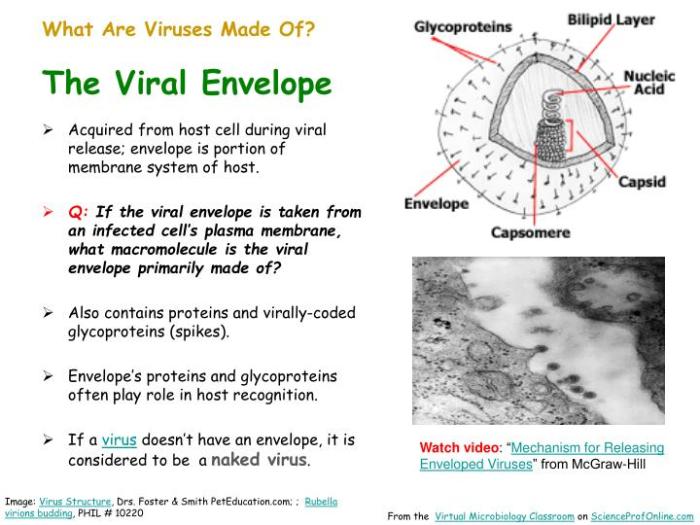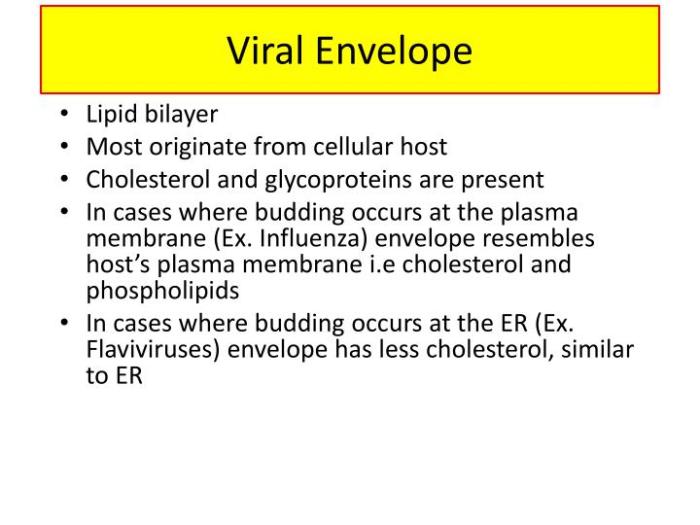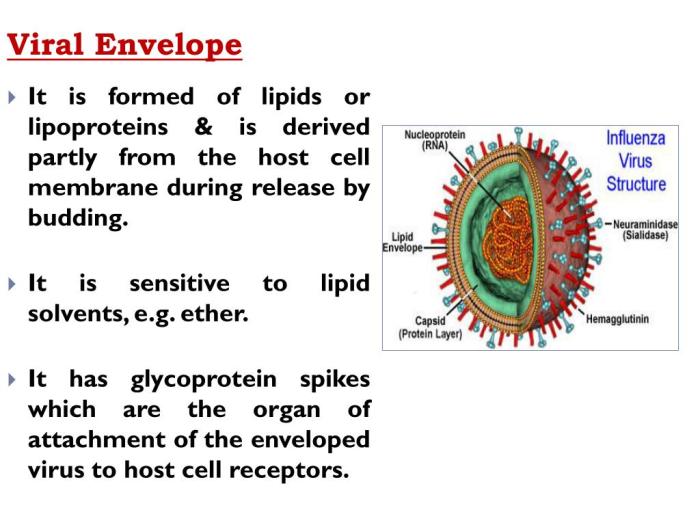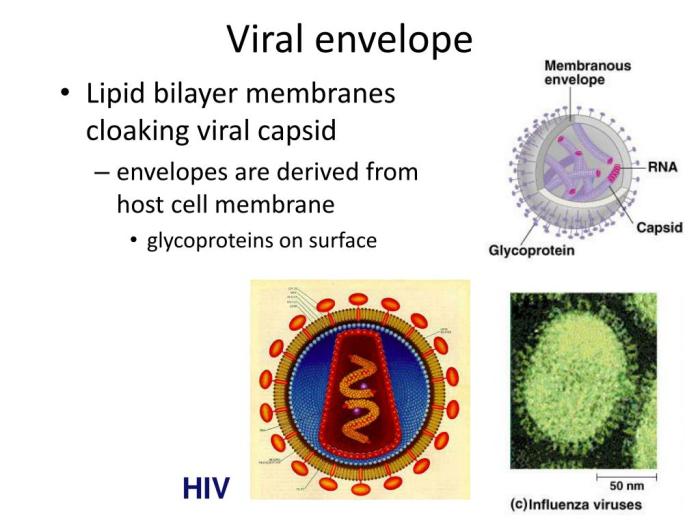The viral envelope closely resembles the host cell membrane, providing a cunning disguise that allows viruses to evade detection and invade host cells. This remarkable adaptation plays a pivotal role in viral entry, replication, and pathogenesis, shaping the intricate interplay between viruses and their hosts.
The viral envelope, composed of a lipid bilayer studded with viral glycoproteins, mirrors the structure of the host cell membrane. This molecular mimicry enables viruses to seamlessly integrate into the host cell, utilizing viral glycoproteins as keys to unlock the host cell’s entryways.
Similarities between the Viral Envelope and the Host Cell Membrane
The viral envelope closely resembles the host cell membrane in its structure and composition. Both the viral envelope and the host cell membrane are composed of a phospholipid bilayer, with embedded proteins and glycoproteins. The viral envelope also contains viral glycoproteins, which are responsible for facilitating viral entry into the host cell.
Role of Viral Glycoproteins in Viral Entry
Viral glycoproteins are essential for viral entry into the host cell. They bind to specific receptors on the host cell surface, which triggers a series of events that lead to the fusion of the viral envelope with the host cell membrane.
This fusion allows the viral genome to enter the host cell, where it can replicate and produce new viral particles.
Viral Evasion of the Host Immune System
The viral envelope also helps the virus evade the host immune system. The viral glycoproteins are often glycosylated, which means that they are covered in sugar molecules. This glycosylation makes the viral envelope less recognizable to the host immune system, allowing the virus to escape detection and destruction.
Mechanisms of Viral Entry Mediated by the Viral Envelope

Viral Fusion Proteins
Viral fusion proteins are essential for mediating viral entry into the host cell. These proteins are located on the viral envelope and are responsible for fusing the viral envelope with the host cell membrane. Viral fusion proteins are activated by specific triggers, such as pH changes or the presence of specific receptors on the host cell surface.
Manipulation of the Host Cell Membrane
Viruses can also manipulate the host cell membrane to facilitate their entry. For example, some viruses use viral proteins to disrupt the host cell membrane, creating pores that allow the virus to enter the cell. Other viruses use viral proteins to hijack the host cell’s endocytic machinery, which is normally used to internalize nutrients and other molecules.
Viral Budding and the Formation of New Viral Particles: The Viral Envelope Closely Resembles The

Process of Viral Budding
Viral budding is a process by which new viral particles are formed. During viral budding, the viral envelope buds from the host cell membrane, encapsulating the viral genome and other viral components. The newly formed viral particle is then released from the host cell and can infect other cells.
Role of the Viral Envelope in Viral Budding
The viral envelope plays a crucial role in viral budding. The viral envelope provides a protective layer for the viral genome and other viral components, and it also contains viral glycoproteins that are essential for viral entry into new host cells.
Evasion of the Host Immune System, The viral envelope closely resembles the
The viral envelope also helps the newly formed viral particles evade the host immune system. The viral glycoproteins are often glycosylated, which makes them less recognizable to the host immune system. This allows the newly formed viral particles to escape detection and destruction.
Role of the Viral Envelope in Viral Pathogenesis

Viral Tropism and Host Range
The viral envelope plays a role in viral tropism and host range. The viral glycoproteins determine which cells the virus can infect. For example, some viruses have viral glycoproteins that bind to specific receptors on only certain types of cells.
This limits the virus’s ability to infect other cell types and restricts its host range.
Viral Pathogenesis
The viral envelope can also contribute to viral pathogenesis. For example, some viruses have viral glycoproteins that can trigger an inflammatory response in the host. This inflammatory response can lead to tissue damage and disease symptoms.
Therapeutic Implications of Targeting the Viral Envelope

Antiviral Drugs
The viral envelope is a potential target for antiviral drugs. Antiviral drugs that target the viral envelope can inhibit viral entry, replication, or budding. These drugs can be used to treat viral infections and prevent the spread of viruses.
Challenges and Limitations
There are challenges and limitations to developing antiviral drugs that target the viral envelope. For example, the viral envelope is often highly variable, which can make it difficult to develop drugs that are effective against all strains of a virus.
Additionally, some viruses can develop resistance to antiviral drugs that target the viral envelope.
Successful Antiviral Drugs
Despite these challenges, there are a number of successful antiviral drugs that target the viral envelope. These drugs have been used to treat a variety of viral infections, including HIV, influenza, and hepatitis B.
Essential Questionnaire
How does the viral envelope help viruses evade the immune system?
The viral envelope displays viral glycoproteins that mimic host cell surface molecules, allowing viruses to camouflage themselves and escape recognition by immune surveillance.
What is the role of viral fusion proteins in viral entry?
Viral fusion proteins mediate the fusion of the viral envelope with the host cell membrane, creating a pore through which the viral genome can enter the host cell.
How does viral budding contribute to the formation of new viral particles?
Viral budding is a process where new viral particles assemble and bud from the host cell membrane, acquiring their lipid envelope in the process.